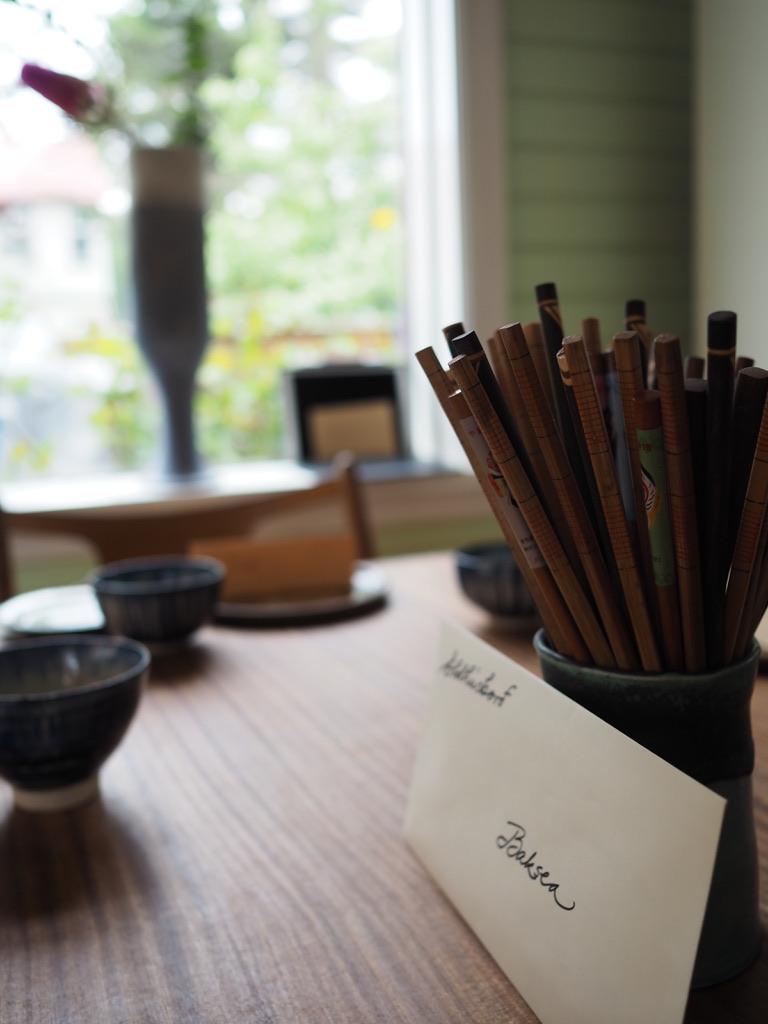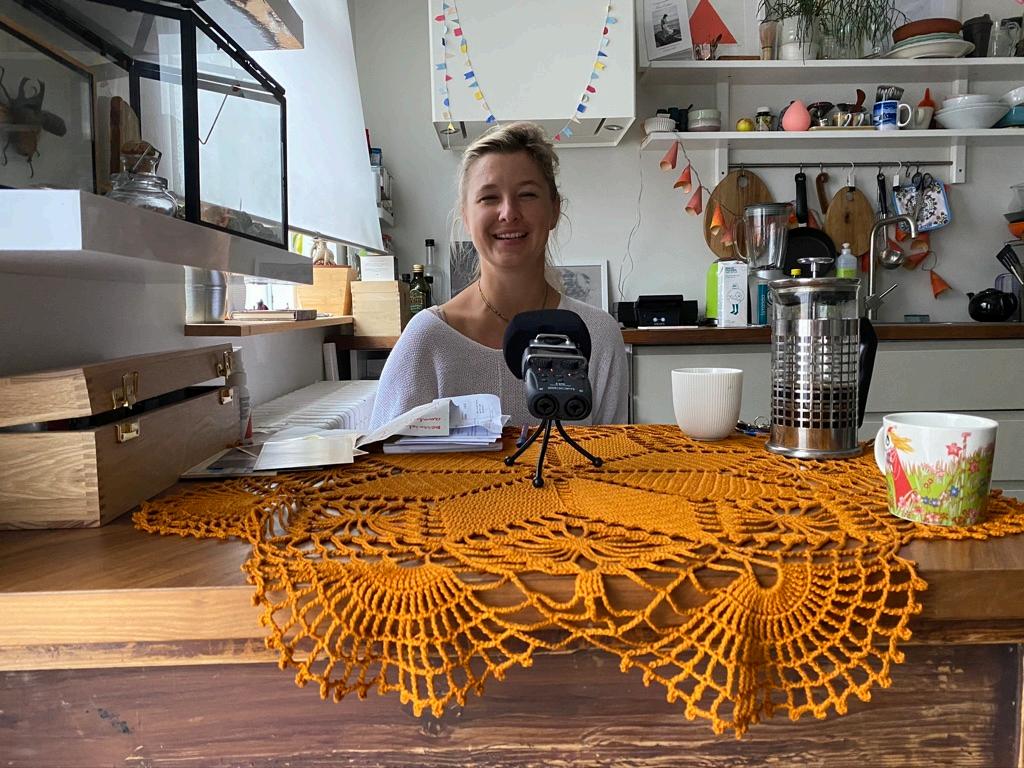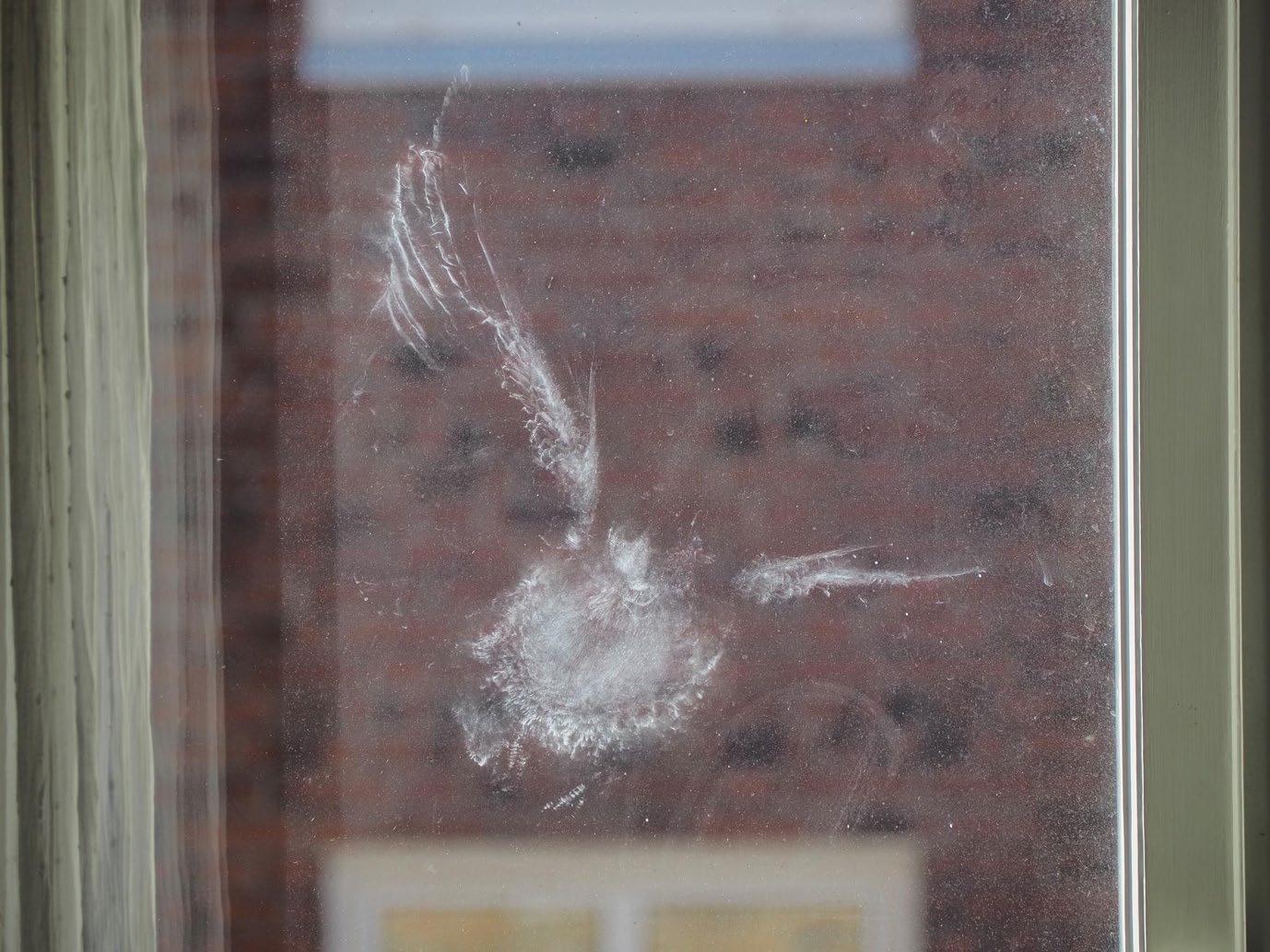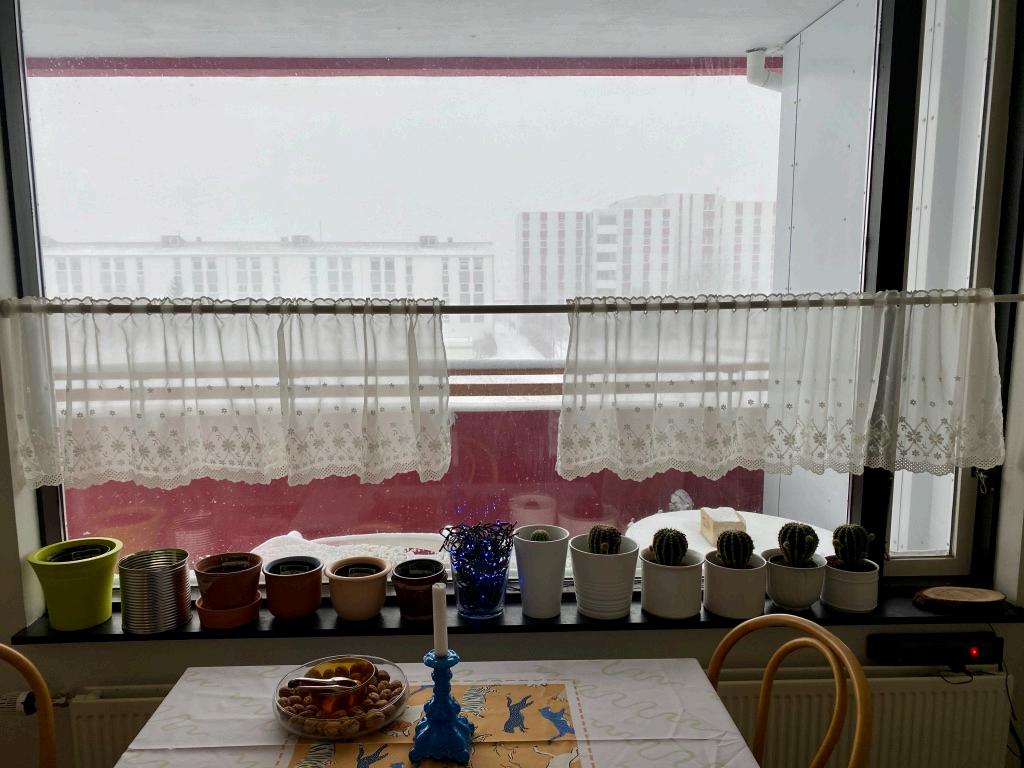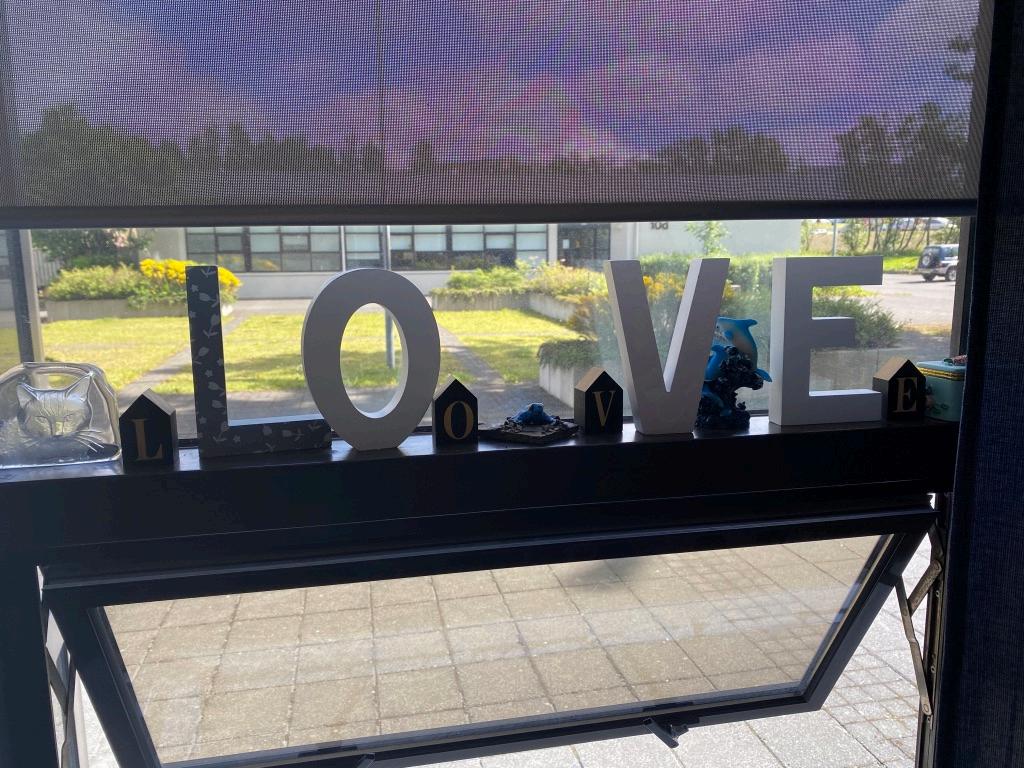
50 minute read
LETTER THREE, AFFECT
LETTER THREE
AFFECT
Advertisement
Dear reader.
We are now entering the core of my research; were I will unravel the affect and potentiality of my artistic methods. You will be exposed to graphs showing collected data and you will be hearing the voices of my spectators and collaborators. I will talk about how the artistic methods affect my spectators and how their experiences inform my practice and create knowledge and potentially new artistic methods. In the letter I address the concept of affect in relation to my practice especially the work No-Show, a series of immersive participatory performances in private homes in Reykjavík in the summer of 2020. I will account for my understanding of the concept and how it manifests in my artistic practice. The letter contains many threads that will not be tied together at this point since I am still at the point of creating openings. To understand the affect of the performance No Show and to find out how particular aspects of my artistic method and aesthetics worked, I gathered data from both the participants and guests about their experience. I decided that I would use different methods that would both give me an overview of the general affect of the performances and also an insight into personal experiences. I created a post performance questionnaire that the majority of the guests of the performance filled in. I recorded audio interviews with the hosts before and after the performances and I also took 18 interviews with 17 guest that had gone through one or more editions of the performance. I will give an account of how the interviews, together with data from the questionnaires, informed the process and created awareness, understanding and new knowledge to me. I will also give a brief insight into how this data informed the following artistic work, The Island, and how I foresee my research method developing. Before I dive into the practice and start to give an account of my findings, I will clarify what I mean by affect, why I think it is relevant and how I see it unfold in my work. The letter has three sections with the headlines: Affect, Questionnaire and Interviews.
Affect
When I talk about affect, I mean the sensorial and cognitive influences of an experience, that evoke physical sensations, emotions and thoughts. My understanding of affect is inspired by many thinkers that influence me in different ways. I have accepted Donna Haraway´s call of staying with the trouble (2016) , Eve K. Sedgwick is helping me think through the senses (2003) and Deleuze and Guattari’s definitions on percept and affect (1994) have opened my eyes to what the work actually is. The work I am striving to produce is in fact an affect. I can describe the composition, the route or the elements in play in my performances but I will not be able to describe what each spectator defines as being the work. The art and non art are almost inseparable. The experience is sensorial with all the complexity that entails. The full body of the work does not have a pre-designed effect but works differently for each guest encountering the work. It is through being present, touching, feeling, sensing, meditating, acting, reflecting that the spectators generate the work, and it takes shape as an artwork inside them. The artwork is the bloc of sensations and reflections that emerge inside of the
spectator while struggling to travel through the performance and perform tasks such as dance in a wheelchair. This was the case in the edition 105 of No Show, where the spectator is invited to dance to the song, I want to brake free, sung by Freddy Mercury wearing women clothes, in a video playing on the screen of a laptop that is placed on a living room table in a stranger‘s home and there is a black cat observing in bewilderment. The guest here is invited to a complex physical action in a strange environment that triggers multi layered affect, that is both sensory and cognitive. In any given moment there are multiple stimulants that evoke different things in all of us. I have chosen to work with immersive participatory art form where the experience in itself is the artwork, not what I have produced as an artist but the affect of the situation I have invited into. I am staying with the trouble and I am inviting the spectators to stay there to. The boarder between art and non-art is erased and I embrace my loss of control of what the work entails. What I am looking for in my performances are liminal experiences that are potentially revelatory and life changing. Fischer-Lichte, a leading theorist on transformative powers and aesthetics in performance describes the relation between affect and transformation like this: “While the excitement of affects transfers the
spectators into a liminal state, catharsis brings about the actual transformation“ (Fischer-Lichte, 2008, p. 191). It is on this correlation of experience, affect and transformation that I focus my attention in my encounter with the guests of No-Show through the interviews. Before we go further, I have to make an important statement: I am an artist researcher, I do not pretend to be social scientist, my readings of the testimonies are subjective, based on my intuition and previous experiences especially from performance making and being a spectator myself. Let me now slip into the lab coat and introduce to you the quantitative data I collected through questionnaires at the performance site and how I interpret the subtracted data.
The questionnaires
I decided early to create a questionnaire to have a feedback on the staging, the format. The guests of No Show were offered to answer a questionnaire on site straight after their experience. The guests had peace to do this while the employee from the art festival was preparing the home for a new guest. Through the questionnaires I wanted to understand what the guests regarded as being the work, how the work affected them, what emotions did they feel and what parts of the performances made the greatest impact. I wanted to understand if the guests regarded themselves as the subject. I wanted to learn how the guests understood their role as participants in the piece. Also, I wanted to collect some perspectives on the concept How little is enough? by asking if the guests regarded it as a performance or a theatrical experience and if not, what was missing. 76 guests filled out the questionnaire that was anonymous. (See Questionnaire in appendix). I have created graphs from the result that I will interpret before we move to the more in-depth perspectives of single voices. As a performing artist I thoroughly enjoy the performativity of these graphs, for me they are highly informative, but I also find them extremely playful.
The staging

To the question if the guests regarded the work as a performance or theatre, 66 of 76 answered yes and only one did not think this was staging, 9 were not sure. For my research these findings are affirmative since the question on how much production is needed to create a stage performance is central to my research and my artistic method. Together with supporting data from the interviews where I ask specifically about the staging, this information gives me knowledge about the theatrical affect of the artistic method that I can use in future performances. The interviews entail more details of what the guests regard as being staging or theatrical, such as a story, a new world, dramaturgical structure, arrangements or composition. The data suggests that what was produced in No Show was enough to evoke a sense of performance. Here expressed with the words of one of the guests: “It was so incredibly casual and yet very impressive, just with little things that do a lot.”
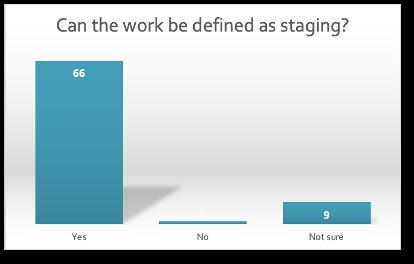
The participation and the participant Do you consider yourself as a There is a twofold question on participation and participant ? the role of the participant. Firstly, I ask the guests if they consider themselves to be participants
69
were 69 answered with a definite yes. There is no doubt that the work invites its guests to 3 5 participate. Yes No Not Sure The second one is if they consider the piece to be about themselves. Here we see a distinctive divide. To this question some guests even gave two answers, both yes and no. 41 answered that the piece was about them and 30 did not think so and 10 guests where not sure. This suggests that there is more to this point, something that cannot be expressed with a definite answer. In the interviews Do you find the piece is about you? I asked people about how much of the piece was about the host and how much of the piece was 41 about themselves and what they shared with the 30 host. The result to that question (see picture in the interview section) shows a mixed view. The 10 answer seems to depend on how much you relate Yes No Not sure personally to the host and also on what you consider as being the work. I guess that this last point, what is the actual artwork, will affect how you perceive your role as participant and how relevant you


regard your personal story to the artwork. This is a topic that needs more focus and I foresee being a central thing in coming questionnaires and interviews for my future works.
Who are the guests?
How often do you attend site specific performances
29
16

13
9 8
often Sometimes I happens Very rarely Never, this is first time I wanted to know how familiar the guests were to participatory site-specific performances as I imagined it could affect how they navigate the work and also what they consider being the work. Majority of the guests were familiar with this type of performances and I did not detect any significant differences in the answers from guest with different experiences of theatre and performance.
Emotions

One way of measuring affect is to ask about felt emotions, this I did. I am interested in creating a positive affect, that re-enforces the guests understanding of what they consider quality of life. Positive affect is not only created by positive emotional responses, but as I understand it, by affirming sentiments, appreciation, understanding, connection and belonging. Emotions are complex and can be double sided and can evoke memories and hidden components. The guests could mark one or more emotion from a list of 11 different emotions and guests could add relevant emotions in an empty space. The selection of emotions is based on my special interest and do not reflect a system or a theory. I will not attempt to understand the full scope of what the answers might imply. For me as an What emotion did the work evoke in you? artist, it is interesting to
Curiosity 57 understand what emotions
Wellbeing 53 are present in my work Joy 50 Trust 48 and try to make use of this
Acceptance 44 information in my artistic Vulnerability 33 Sorrow 32 methods. The interpretations are both 2 subjective and speculative. A general conclusion is that the work evoked mostly positive emotions. Curiosity, wellbeing, joy, trust and acceptance had the highest scores of the 11 emotions presented in the questionnaire. After these emotions came sorrow and vulnerability.

Irritation 7 Insecurity 6 Fear
Anger 1
Looking at the overall picture with the addition of the specific emotions that guest contributed with, the work seems, in general terms, to evoke emotions of wellbeing and joy, it also seems to evoke positive emotions towards the host such as
trust and curiosity, and even emotions that can
belong to empathy such as sorrow, vulnerability and acceptance. Written comments on the questionnaires suggests that the sensation of being trusted with the home had a great impact on guests, this is also supported in the interviews. It seems like being trusted has an affirming affect that urges one to be worth the trust. Next to these affirming emotions are vulnerability and sorrow. These emotions can suggest that guests are touched beyond the surface and might imply a certain existential notion. The answers differ slightly from home to home, that might suggest that the type of home and 5 information given evokes more or less sombre feelings since the sombre emotions appear more in the homes where the hosts share experiences of loss and struggle.

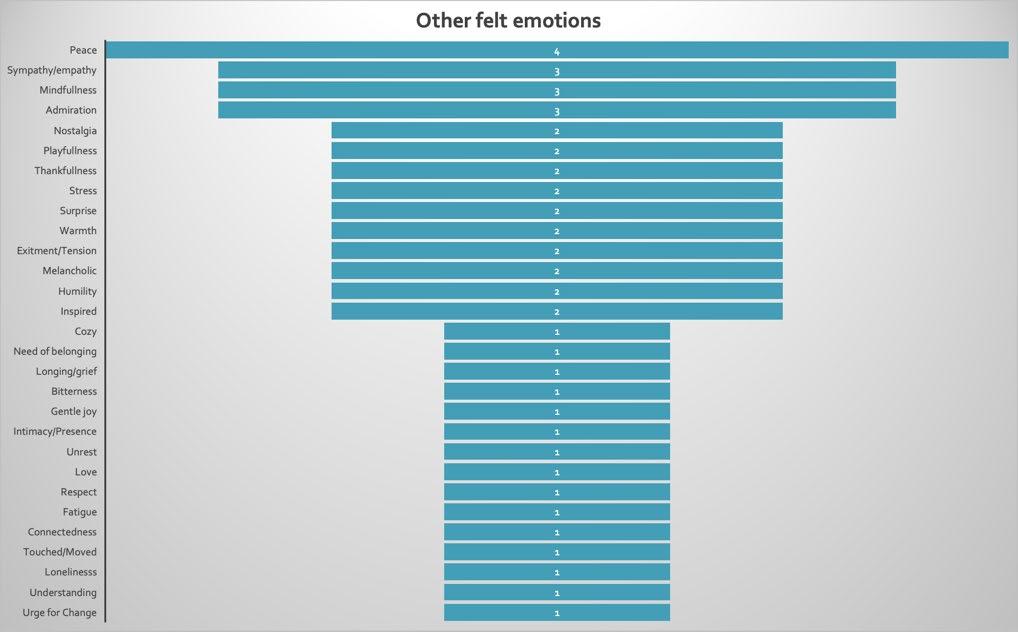

108, Búland
Curiosity 10
Wellbeing 14 Joy 8 Trust 12 Acceptance 7 Vulnerability Sorrow 4
Irritation 4
Insecurity 3 Fear 2 Anger

Curiosity Wellbeing Joy Trust

Acceptance Vulnerability Sorrow

Irritation
Insecurity Fear
Anger 101, Klapparstígur
12
15
12
8
14
5
4
Curiosity Wellbeing Joy Trust
Acceptance Vulnerability Sorrow
Irritation
Insecurity Fear
Anger 111, Asparfell
11
8
8
7 8
9
9
1
Curiosity Wellbeing Joy Trust

Acceptance Vulnerability Sorrow

Irritation
Insecurity Fear
Anger 101, Framnesvegur
8
9
9
11
9
5
5
Curiosity Wellbeing Joy Trust
Acceptance Vulnerability Sorrow
Irritation
Insecurity Fear
Anger 105, Hátún
16
7
13
10
6
9
10
3
2
At this point I want to quote one of my interviewees, lets call her Sally, talking about emotional affect of the piece in comparison to what she sees as a symptom of our times:
So much of arts just create any sensations [that is] why there is often so much of a splatter and rape scene and all sorts, just somehow to shock, just to create “any” emotion instead of nurturing the beautiful feelings and constructive feelings and the all-encompassing feelings and the warm feelings. (Sally)
I agree with Sally in her appreciation of these warm and encompassing feelings in favour of more invasive power of violence and trauma. Looking at my data, it looks like I have succeeded to evoke these more affirmative emotions in No Show.
What made the most impact From the questionnaires I collected over 80 written answers to the question “was there a part of the performance that made most impact on you?”. As expected, the answers were very different, and each guest related personally to specific things. Also, guests related to aspects of the work that evoked strong emotional response, e.g., recognition or empathy. The most common comment was “To be trusted with the home” and strong emotional affect, like love or sorrow, “The bathroom - the thoughts about love” and “The girl on the wall, the picture of Flateyri, the childhood.” Many guests also mentioned that having your name written on the dining table had a strong impact of acceptance and relatedness, like being a part of something. “To enter the flat in the chair and to see my name on the table, it triggered a lot of emotions”. The comments are a valuable tool for me in developing my artistic methods further, to better understand the impact of certain elements, situations and arrangements. One affirmative aspect of special value to me was the mention of care in the work “The letters and the care that they presented.” This comment resonated also with many of the interviewees where they describe a sense of warmth and tenderness that they felt through the letters and how the home was prepared. This I cherish and want to pursue in my future works. This type of questionnaire is a kind of quality check that gives me a quick indication of how the piece works.
The interviews
Since my research is on affect and the transformational potential of my works, I needed to conduct interviews with my spectators. I later felt that this became an important and powerful part of the work for those who participated. Through the interviews I wanted to understand what happens to people while experiencing the work and after. I was interested in the details of the personal experience. The 17 subjects were from age 19 years old to 69, both men and women that had volunteered by writing their name on a list after answering the questionnaire on the site of the performance. One
person I interviewed twice. From 17 interviewees, 10 were artists or culture workers. I picked out the people from a long list of interested spectators. From the list I chose 4 to 5 people from each edition of the performance, people of different backgrounds, sex and age. Some of the interviews were conducted straight after the experience, others later and up to six weeks after the performance took place. The interviews were all around 30 minutes and were semi-structured. In a semi-structured interview, the researcher asks a few open questions and lets the responses the interviewee gives inform what questions are asked next. The interviews were made in a quiet place of the interviewee‘s choice, in my home, their home or at a cafe or hotel lobby. I began with an open question; asking the interviewee to describe their experience in general terms. Based on their descriptions I then asked them directly about their reactions to different aspects of the piece, certain moments or elements of my method. I then asked how likely they thought it was that the experience would affect their mindset and/or behaviour and we would discuss in more general terms about methods of theatre and performance and their general attitude towards different theatrical approaches. I asked each person what the piece was about and if they found the piece more about the host or the guest, themselves. I did not ask the guests if they liked the work and did not seek affirmative responses. As the author of the work conducting the interviews, I was aware of the risk of trying to influence the answers and tried the best to avoid judgement and stay with detailed descriptions of their experiences. Since the interviews were taken along the way while I was still making works, I had the opportunity to experiment with details in the work responding to the data I was collecting. The interviewees are all anonymous and appear in the text with pseudonyms. The interviews were conducted in Icelandic. I transcribed the interviews accurately and after several readings, made a selection of texts that I translated to English and analysed further. I detected many recurrent themes that I am currently processing and will now present to you. First, I will introduce a theme that relates to the different aspects of solitude, then a theme that relates to the work being a catalyst of change. A larger territory is how the guests relate to the content, that I divide into four sub themes: the host as a role model, the guest as subject, guest identifying with the host, and abstract experience. I will present themes on sensations, care and connection and themes that relate to the subject of the work and what the guest brings to the piece.
THE GUESTS
The many sides of solitary experience
In the first interviews I conducted after the second edition of No Show, there were already important findings that would immediately affect how I proceeded with the work and also influenced how I approached my later work Island, that I was creating concurrently. These first findings relate to the fact that the performance is a solitary experience and is unique to each guest. This solitary experience comes with specific aspects to it. One guest described the feeling like this:
When you are alone, you allow yourself other, stronger emotions, you allow yourself to surrender to it, you do not have exactly the same fences, the same restrictions around you, I am not talking about movements or anything like that, I am talking about emotions and what goes through you, you allow yourself to experience, exactly the same as if you are experiencing something in nature, something very beautiful in nature, then you are experiencing maybe, e.g. in this work some kind of nature too, yes this is nature. (Albert)
The experience has specific potentials as other guests also described to me: they had more influence over the situation, they could control the pace and they could choose to skip tasks and revisit scenes etc. and give themselves the permission to dwell.
It was also just privacy; you are naturally alone with yourself and your thoughts and affects and that was also one of the things […] that I was so grateful for, to have this privacy to allow the emotions and thoughts to go off like that. (Gloria)
Another aspect to being alone is that you do not have another person to talk to about the experience.
“It's not often, that you're just alone, it's a completely different experience and it was too, you know, I knew someone was going two days later, well, I was pretty excited, and it was hard not to be able to talk about this. [...] I just had to figure out what I really felt without being influenced by anyone else or anything [...] so, there I had to work on this all by myself, somehow ...” (Anne)
The many comments I got on the solitude and what I understood of what comes with sharing an experience with another person or persons made me change my dramaturgical strategies for Island. So, in the work Island, the guest enters the work as a part of a small group and is in close contact and in interaction with other people throughout the experience.
Another important aspect of being able to share your experience has to do with dissemination of what happens and the awareness of the affect the work has on you and the potential transformation.
I'm sure this work has a much bigger impact on me right now because I've been talking to you so much about it. …
…There is something about sharing an experience with others that makes the experience a little stronger or can do it. (Angela)
The work as a whole, stimulates me most here at this table in these afterthoughts and maybe you know, too to say it out loud or understand what I mean. It stimulated me then and there but its like I am feeling the stimulus here and now. (Bella)
Many of my interviewees talked about the urge to discuss the experience with others, that they became more aware of the affect if they had the opportunity to discuss their experience with others. Talking about the experience made them aware of details in the work that they had not paid attention to while in it and also made them conscious about where the affect originated from. This gives me an insight into how people process the work and what they believe has an impact on them. For some, the questionnaire provided an opportunity to go through the experience and start to process the affect. This recurrent theme in the interviews made me understand that for a work to really grow on you it needs to be revisited and processed through communication of some sorts.
Another aspect of the solitude is the guests lack opportunity to communicate back to the host that has a voice through the letters. In the first two editions the guest did not have any opportunity to communicate with the hosts.
This is such a gift and I accept it and I can not directly thank her for it you know, I really feel that it is missing, it was so emotional, I felt like a bit rude somehow. (Bella)
The only way the guests had to show their gratitude was through the questionnaires. Many guests expressed a longing to communicate with the hosts or at least be able to do something in return for the hospitality. An element in the first two editions was to invite the guests to write a list, a note to themselves, inside the work and take it home with them. I decided to change that to inviting the guest to write something for the host instead and leaving it behind. This I tried in two editions of the work.
I found this somehow beautiful, but I also found it incredibly difficult but still it was good to write her a message [...] Hopefully she got something out of that. I hope so at least. (Ella)
To hear about the word box and to be able to contribute to that
(anonymous answer to What made the most impact on you?)
Catalyst of change
In retrospect, I think there is value in both leaving a note to the host and writing a note to yourself that you come back to after the experience. A note that you take with you makes you revisit the work and can act as an enabler for deeper affect or even drive to action.
My brother and his wife, they have been picking up their notes quite often since then and just think, hmm, “just here you see, what do you think about this or I'm been thinking about this. (Sally)
Here we could talk about that a physical object from the piece has become a catalyst for change, other objects can be less tangible but be still as effective. Sally shared with me how her family decided to go together to see No Show. They were 10 people that visited edition 101 City Centre. and then they organised a dinner party where the shared their experience. Later they went to see edition 101, West town.
Everyone who was at the dinner party talked about how they wanted to reorganize their home [...] everyone wanted to create more cosiness at home, everyone wanted to find more peace. I find it incredibly remarkable that you create a work so that people want to change their home, because they saw your work. (Sally)
Creating a sense of awareness or moving the spectator to action is the desired outcome. Here it seems to manifest in the way these spectators are inspired to rethink and redesign their living spaces in order to improve their quality of life. Since the works are performed in homes with a focus on daily rituals, everyday situations and the small details of daily life, most guests can easily reflect and relate to the content.
There was just somehow such great beauty in the little things. (Bill)
I have a hard time with everyday life somehow, I find it the hardest part of life and still it is such a big part, so, […] I took it further with me, you know, everyday life is so crazy, especially if you are reading about someone else's everyday life, because then you can imagine and create, you can still somehow, change your own, or see your own, often you just keep going without contemplating anything in what one is doing or one way or another, so I think most in this work, what I take with me [...] these little things are so very important. (Anne)
The hosts became role models or examples of how one can perform these daily rituals and the work also provides the context and puts things in perspectives of value systems and life situations. The values and behaviours of the hosts easily become contagious.
She was so inspiring. To just understand how she sees all the good in things and how she takes full advantage of what she has but, yeah, this was just amazing, just unbelievably inspiring. (Johanna)
I was immediately inspired e.g., of one thing in this home […] was the dinnerware that was handmade, and handmade for this family, there was something there that I felt something so amazing. I thought why I have not long ago started to make my own dishes for my [family] you take the time to nurture these everyday things [...] make them precious. (Gloria)
I've been thinking for a long time about wanting to work with either elderly people or children or something, [...] be some volunteer, work with people who have a harder time living life and this could just be something that, at least it was like something that helped me, maybe direct my thinking [...] I'm finally going to do something. (Bill)
Half a year later, this young man was indeed working with children and found it important and meaningful. Another spectator described how she started playing the ukulele after writing it down when asked in the work to make a note listing things she wanted to learn, and taking it with her, expressing how the note pushed her into taking the first step.
Four ways of relating to the content
In the interviews people described how they related to and were affected by the content, the hosts or the experience. I can divide these experiences into four categories; the host as a role model, the guest as the subject, the guest identifies with the host and abstract experience.
The host as a role mode: For many guests the host became either a role model, as described above, or a relatable person that the guest could recognise themselves through:
I really connected with the fact that she's a former nurse or something, yeah, yeah, I'm there now, or something like that, we were like pals, and her values were so
healthy. So just being here, creating a sanctuary for her children and grandchildren and that was enough for her, she felt like the big bedroom was to big, she needed less. If she manages to be a sanctuary, then she's satisfied, there's something like that that I found so beautiful, I [...] was a little spellbound, like, she was such a role model, a mentor, a lesson, what I needed so much. (David)
Here David both relates to the host and sees her as a mentor, a double hook that I think can amplify the affect.
The guest as subject: Many guests described how they were confronted with themselves, with their predetermined judgements, inner thoughts, values and experiences:
I can be quite frank with the fact that I have been wondering […], should we say that this way: I looked at my Breiðholt (name of the neighbourhood of edition Reykjavík, 111) prejudices through this work ... so I think that, if anything, my prejudices about Breiðholt diminished. (Michael)
It affected me (...) to sense that maybe people, people I see, just the guy who was helping, as soon as I met him again, I thought, yes, he's in a car like that, yes, I think he is of foreign origin, so I immediately start thinking about him, not only the first thought, but also, I expanded my ideas about people, I think, at least, first afterwards…
... more such acceptance of people that it is, it is much bigger, much more complex, much bigger. I think so. It had that affect. (Albert)
What is described here is profound revelations about the other. Both Michael and Albert spoke about changing their views on people, they acknowledge how they confront their own ideas. Other guest expressed similar changes. But as Albert says that it affected him “at least first afterwards.” This is a significant remark since I think that the longer the affect lasts determines the power of transformation.
The guest identifies with the host: The third category is learning something new through the story of another, like you are putting yourself in someone else’s shoes, identifying with them.
When I looked out the window in the kitchen, I was supposed to notice some movement [...] it is hard to describe the feeling, but it was like looking into the future somehow [...] like me, like old looking out the window…
I experienced myself so old and it's so interesting [...] it kind of stayed with me because I'm just young, I'm just turning nineteen, I never think about anything when I get old [...] and also the feeling that I could possibly loose someone, my child or something like that [...] you never think about it when you're young, it's at least very rare so that, yes. Maybe this experience of being old, it's so insane, I have just never experienced this before. (Alice)
You're seeing someone's world, and this is not directly your world, but some other world you are seeing into and it can let you feel some emotionswhether it's sadness, happiness, I mostly just felt some kind of happiness… …I went into her world but still I was not her but somehow, I ... I was not me, but I was some kind of version of me. (Bill)
Of course, [...] this was a real person who lives there, you are experiencing a certain story, it's like you have you are in a novel or a movie or something but it's really real. Right, it was really weird it was like you felt like you were on a set or something, but it still is not, it's just someone's reality, which, it was very interesting you know and also just you know, it just underscores that everyone has their story. (Fanny)
Identifying with another person is the classical approach to theatre. Seeing a story unfold and imagining it was you. In this work the experience intensifies with the “reality” of the setting, like Fanny describes.
The abstract experience: The fourth category is where the experience is more abstract and has an affect like when experiencing nature.
It was simple, it was physical, and it was a description of the phenomenon stairs, it was very strong somehow, and this intermediate state, liminal space to be there, out in the corridor, to be in a kind of nowhere, and this action to bend the knees, incredibly beautiful somehow, feel the weight of the body somehow and yes, it was a really cool opening somehow into the work and how you were a spectator as a body. [...] I somehow became part of the environment, somehow like that, it was
just my consciousness, this witness, that you see in dreams or that is looking, looking at one's dreams, there was some kind of rupture. (Jimmy)
To walk into a piece like this is like walking up a mountain or some nature situation, a nature scene, it does not come to you unless you, unless you surrender, you have to be here, you can not wait to be fed, you have to be like this, you must not have too many filters for the affect you are exposed to, it is completely true of nature observation just like this, that you have to come in with an open mind and in fact just accept what you think and experience [...] without filtering it too much. and that, of course, applies to everyone, and maybe this kind of performance, is maybe closer to the theatre to the point that [...] you have to accept the magic, otherwise it's just a man with makeup on stage, a smoking mirror, you have to go into the story and accept it [...] you have to sit back in the chair in the living room up there in Asparfell and take it in, this is where it meets the experience of nature, you must come with open senses. (Michael)
I can completely see myself being affected by this experience like when I go out into nature. To see the vision directly, face to face, not on a screen but here, that too, moves me. (Eve)
For this abstract affect to function the person needs to allow the affect to take hold, like Michael describes, you need to “surrender” and “you have to accept the magic”.
Physical engagement
These four different ways of relating to a content and being affected can co-exist in a multi layered experience. As mentioned above the affect is created through sensorial experience in combination with cognitive perception. Most of the guests that I interviewed talked about the strong impact of physical engagement, the doing, the sensing and the entire interactive aspect of the experience.
You came closest in these homes when you touched the floor, barefoot in one of the homes, and in the wheelchair. There was some contact, there you somehow got in touch - but always in fact as an observer of another's life, the life of others. (Carl)
Now I remember all the actions somehow but like e.g., the contemplations and what was the other thing again…. (- observation) yes, exactly [...] now I do not remember what that was …
…I find that one of the most interesting things about this work, how you as an active participant somehow feel much stronger than if you were just seeing this [...] or you were just a passive spectator, yes. (Fanny)
Care, trust and vulnerability
Another important factor that seems to affect the guests is the feeling of hospitality and connection. The majority of the guests I spoke to describe a feeling of being seen and cared for and things being prepared with care and attention to detail. The one detail that almost all mentioned was the nametag on the dinner table. To be mentioned by your name is a crucial factor that I was hoping that would have an impact on the guests, and it did.
It's this personification, your name on tag at the table [...] it gives the feeling that you are, or I felt, I was part of the work. (Michael)
I felt welcome, because, you know, your name was there, somehow, not just a guest or something but completely, the name, my arrival had been prepared for. (Anne)
I thought it was nice to sit at the table [...] I chose a seat and then I first saw that my name was on a card exactly by the seat I had chosen, this was so funny and pleasant. It felt kind of beautiful to be one of the group, one of the family. This is such a magic, suddenly seeing the card with your name…
…I felt welcomed, warmth, intimacy, affection it's like it was beautifully wrapped, I appreciated that and yes, no, no, I was just led into something, it was not staged, more like a gift, a present. (Charlotte)
I felt like this was you embracing us with your tenderness so we could be more us. (Sally)
Another central theme was trust. Majority of the interviewees mention how being trusted had a powerful impact.
To be given a key instead of someone else opening a door for a you […] there you become so aware of some decision […] you are given both some kind of trust and
responsibility and such and you take it or, so it is as kind of agreement on something. (Bella)
I just think like that, because you are so trusted in the house, you want to be trustworthy somehow, you do not want to betray anyone, you just want to be a decent citizen, this came so strong over me. (Anne)
I am trusted with the home as I am just a stranger visiting a home that is empty and this is where I enter. I immediately felt like this, it was immediately something that had such an affect […] I was immediately [...] humble…
…One is somehow safe but at the same time vulnerable and perhaps precisely vulnerable because one feels safe [...] vulnerable and secure at the same time. I found it interesting to find it. (Gloria)
In this last comment Gloria mentions here vulnerability and safety as being two sides of the same coin. One could describe vulnerability as a kind of openness and here she relates that to being safe. Being safe allows you to be open and thus vulnerable. I am starting to believe that this sense of safety together with a sensation of belonging might be the precondition for the openness that is required for a transformation. When I asked Charlotte, who is a practising psychologist, what she thought was the key factor in helping her clients in transforming their life she answered:
I think that a kind of warmth and caring communication and to share [...] be truthful, do not hide anything, and no fireworks, I think it is effective. I also use it in my treatment, I share, it is not always beautiful what I share. We have all sorts of thoughts, they are not all noble, politically correct, beautiful or... I find it so liberating for the next person. To realize that everyone has all kinds, and everyone has their struggle. (Charlotte)
Here I have mentioned three significant features that I find important to my practice of creating potentially transformative experiences; firstly, to create a safe and caring environment that allows you to open up, secondly to create a personal relationship with the guest, see them and care for them with sincere affection, thirdly to share with them something personal, daring to be imperfect.
Who is the subject of the piece?
I have claimed that the work is what happens inside of each guest, both the experience itself and what the guest brings to the work or the work lures to the light from the guests past or set of values and perspectives into the experience. To understand if the guest recognised themselves being a subject of the piece, I asked how much of the work was about the host and how much about the guest and the things they shared with the host. I asked them to divide the work in percentages between them and the host. As you can see in the picture, the answers are very individual and from the 17 interviewees, only two agree on the work being 50/50, which is the average outcome if the answers are merged. I have an interest to create a
heightened awareness of spectators about themselves during the work and these findings suggest to me that the degree of awareness is very individual. In future works I will pay attention to how I can strengthen the facilitation of self awareness.
But all of my interviewees agreed that they brought something to the work. It is probably impossible not to bring your values and your worldview to any experience, like Jimmy says:
I'm fully aware that I see the world through me with all my prejudices and experiences and so to speak, my formatting, I see the world completely, the world is just me, I see it through my upbringing and all […] It's a good question: Where does the work end and where do I start. Is the work reflexology, one presses some points in me that...? (Jimmy)
What David brought with him into the piece is more concrete:
I had the wrong time, so I came too early and then all of a sudden, I was in a stairwell and people were walking past, it was just all kinds of smells and people from all over the world [...] from Asia and obviously from the east bloc and Icelanders, and a bad smell and a good one, and an overpowering smell and I thought: this is a powerful intro. […] So, this is my story more, and the reason I

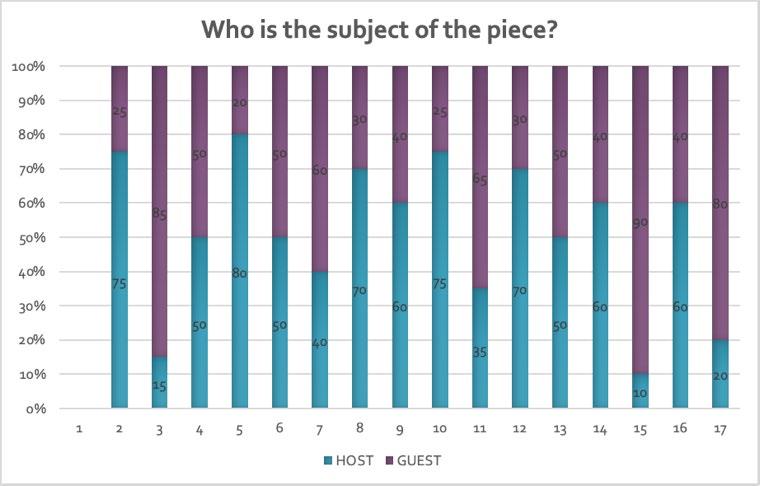
connect with these smells, weird smells and something like that, is because I'm used to these smells from my childhood block, that's my story. (David)
Where does the work start and where does it end?
There are things that are obviously intended as the part of the work such as the situation of each piece, the zip code, so to speak. But the details of what this entails is what the guest determines when he encounters the work. In the example above David sees the smells as being a part of the work and these smells bring out memories that belong to him and are important to who he is and where he comes from, even his value system. There were many guests that mentioned how the work turned ON in them, changing their view on what surrounded them, as Jimmy describes here:
You surrender completely into this space, the theatre, or this side reality, or this portal that art is, when you just open it, there is so little really needed between life and death or here yes, life and art, [...] to go into this, this world, just press the ON button just turn it on. This is what happened when I turned my car into Framnesvegur. (Jimmy)
Jimmy described in great detail a long scene that for him was a part of the performance that he experienced sitting in his car waiting to be let into the home. Other guests also described similar experiences where they described people, situations, smells and sights in proximity to the work, before or after the actual work took place. What I hear them describe is being fully present with their senses open, attentive to the surroundings in a magical mode. This relates to the point from before when Michael spoke about the necessity to surrender. People bring all sorts of things into the piece, such as residues of a bad day at the office or the mood of a world situation that shifts the entire worldview like Bella described to
me:
I went into a mode like this, a mode like the one you are these days, not least in light of all sorts of things, you know world events, and status and something like that, that I felt like this, like this huge privilege. What surprised me was that it provoked me so much [...] it has nothing to do with the people who live there. Coming almost from Austurvöllur (parliament Square), from a protest march or something. But this, when I mention this mode, I think that it is because you only get a beautiful picture. I remember the experience. You are not presented with anyone's struggle story. (Bella)
In this case the outside world situation invaded the whole experience and changed momentarily the perspectives of the guest. What Bella describes are important political events, but smaller issues can affect as easily. The guest can bring anything into the work and there is no control over what becomes a part of the work and what not, potentially everything can:
You were just alone in this and were just experiencing something completely alone while in the movies or in a theatre you can disconnect yourself, you can just go watch yourself, look down on you, “yes, I have some dirt on the pants,” but here everything is connected, so you somehow, all of a sudden everything is part of the same, for some time, in these twenty to thirty minutes, somehow you are all in this. (Bill)
Filling the gaps
The guests not only come with their worldviews and perspective, stories and value system but they are also given the responsibility to create a whole image of the fragments of information that is given to them through the letters and by the surroundings.
The text is very limited, and you just “Take it away”. Your mind just starts spinning. As I may have said more than once that you always start to wonder what is true and what is a lie, what is a staging and what is reality and are there any boarders in it between, it's so hard to set boundaries and define something, what's true and what's not true. Everything is partly lying and partly true. (Carl)
You get a lot of information in a way, because we tend to draw our own conclusions. If someone tells you [...], here I live, I'm so old, I've been doing this during my days, my family is made up of this and this: From relatively little information, you draw all sorts of conclusions about what has, what has happened. (Michael)
This is of course a study, I'm researching this person, this is of course a study of her and a study of my reactions to her that I found exciting because, because I kind of control where it goes. (Albert)
The guest creates the work, it is her that brings together the bits and creates of it a whole, a melange of what a single person can become aware of in 30 minutes encountering a stranger’s home.
I found it so amazing how one small letter can somehow open up a lot for a person, just the connection between this letter and where you are, both the home, where you are in this home, and also where you are yourself as a guest. This home, a guest in this life that you are only getting to know and, in a way, somehow, where you are in your own life and this kind of volatility in between, my life, the life of these people in this house and this flickered there. (Gloria)
Having experienced these interviews and listened to these testimonies I realised how important it was for these people to have the opportunity to share their experiences in detail. I felt somehow that I was witnessing a transformation in progress and I understood that the revelatory moment was not during the performance but came with the reflection on what the guest had experienced. The experience created an urge to continue to deepen the experience by sharing it with someone. This points to the conclusion that the transformation not only needs both body and mind (physical experience and reflection) but proximity and distance as well. The ultimate transformative encounter happens when the actual performance is over, and the spectator leaves the arena with the affect inside to be further developed into something new. In my experience the post performance interviews acted as this catalyst or as recognition of the impact of the experience in some cases. Majority of my interlocutors expressed an appreciation of the interview being helpful and revelatory, that they remembered more and understood more in detail what had affected them and how it remained with them unconsciously and consciously from the time experienced. This is one of the most important discoveries I made during the
process. These testimonies will continue to be a source of discovery. There are still many threads to be picked up and weaved into my artistic practice.
THE HOSTS
The work did not only affect the guests, but also the hosts. I had chosen hosts from different layers of society, all women, a fact that dawned on me in the midst of the process. The hosts did not have particular expectations to the work and expressed curiosity and trust in me as an artist, and the fact that the work was programmed by the Reykjavik Art Festival contributed to the trust they had for the project. One explained her motivation for participating like this:
I like what art does, because it breaks up everyday life, and I not only find it enjoyable but necessary. I feel it is very necessary that things are not always as monotonous as life is. It's just a new perspective on what others are doing and what I'm doing, through the arts [...] and I feel it's necessary - not just a bonus to life but a part of life and necessary.
Generally, they felt positive about the process and the outcome.
I had not formed any opinions beforehand, because I was just going to see how it developed before, I formed any opinion. I did not have any expectations. But it all came out very well.
I think I'm very grateful for the work, it was a bit of a mystery trip, I did not know where it was going and when you created the text from the interview, I got a really warm feeling. I found it incredibly beautiful how you could see my story and how you experienced it and put it into words. I often find it hard to share this story and it was like a maze to me but then you came up with this and it was just somehow beautiful and simple and clear, […] so there came kind of warmth with your text and security too. It was a very beautiful and enjoyable experience to get into this little adventure.
The process created more awareness of the host´s values and life situation, and evoked sensations of gratitude and appreciation of privilege.
You know, you go through everyone's movements, everyone's rituals, […] how we are and how we behave and here, yes, it's has become more tangible everything you do. […] and now I'm just looking at these rituals, they are there, things become visible that were […] unconscious before.
... I feel a real privilege and am very aware of it because it certainly is not like that everywhere. So, to speak, quite yes, yes, it came back to me quite many times, wow, how lucky I am. my husband got a lot out of it, he was all into it and could somehow dwell in the work, [...] what did he say again [that it was] just very clear, the form, structure of everything and he felt the content had a great impact, he felt it had a great and strong effect on him. To see himself through me then also, and through his own
home, to be able to be a spectator in his own home [...] he thought it was just amazing.
As the work focuses on quality of life and affirmative emotions the hosts saw their own homes and life stories in a new light that had a great impact on them:
You know, I must mention it, that I felt shame for many years to be an immigrant and ashamed to have this story - to come here, to look for work, to look for work for my family, and to try to save everyone, such an unease that that came with all this. As I get older, this is diminishing, this immigrant shame I experienced. I thought, to get such positive attention, that is was dignifying, I got back a kind of security.
What you write is very positive, positive about me and my home or family and I think I, that it has given me a lot, because basically I am rather negative towards myself, so that it has given me a lot to get such a positive image.
The hosts describe a mostly positive experience of having people into their homes since they feel that the work is not only about them but is somehow important in a wider context. They expressed gratitude towards the guest and their notes left behind.
They are all very positive. I found it very amusing, they do not know me personally but yes, good to read, because then you feel, the work gets more value, or worth. This is a valuable encouragement.
It is just quite unique to get such comments in the notes, rewarding and beautiful comments.
The overall conclusion in regard to the work´s affect on the host, is that the work had a significant impact on them as well as the guests. The process as a whole heightened the hosts’ awareness of their values and opened their eyes to the important role of everyday rituals and routines for wellbeing and quality of life, in similar way as to the guests. In general, the hosts gained new perspectives by seeing their life through a positive but still profound lens and in some cases the process had a healing affect. I think that the time the hosts stayed with the project played a role, as well as the ongoing personal sharing that found place in the collaboration between myself and each person. The work was somehow constantly present to them during the whole creation process and beyond, as the artwork was situated in their homes, imbedded in the fabrics of their life. Whereas the
guests experience was ephemeral and more precarious in terms of how long lasting the impact would last. I am only starting my research and already so many doors have opened to me. I am overwhelmed with new impressions and information about my artistic practice and I see ahead of me a long journey of more explorations and findings. Again, I want to emphasise that I am an artist, not a social scientist or a philosopher. I use tools and theories from other fields of study to understand and analyse my artistic methods, not to create or shed a light on sociological or philosophical theories. I am grateful for how the tools and theories from other fields inform my research. These testimonies manifest to me the complexity of a single experience and how potent a porous dramaturgy can be, where you as an artist balance between control and loss of control in an artwork instigated by you and yet runs off on a course of its own, not only in one direction, but multiple directions, as many as the persons encountering it. Through these findings that I have encountered and my interpretations of them, I am able to further develop my artistic methods. One important finding is that the format I am developing and testing out that is based on the concept, How little is enough? does seem to work and allows for steps towards further reduction. There is ample space to reduce the production, giving the guests more space to generate the work. Based on my findings, I now have an urge to create an opportunity for the guest to revisit the work and to disseminate the affect in a close proximity to the experience. I intend to develop new formats for having genuine communication in the work and I will also take seriously the guests need for being safe and being seen. Toward these goals I have already taken some steps in the work Island that I will disseminate in my 50% intermediate seminar. For now, I want to end this letter on affect with the words of Gloria that experienced No Show, edition 101, City Centre in June 2020:
I guess it touched me, just deep somehow to experience this, this vibration, often harmony of these feelings and thoughts that I connected with from my life, also some things that were maybe a little bit alien to me and I feel that are not maybe necessarily present in my life but like that yes, in fact still […] I identified with and live in yes, […] then in the end the doorbell rang and then I was so awake. (Gloria)
In my next letter I will focus on my experience of co-creation and participation from the perspective of ethics.
RITUAL III
You walk into a home of a stranger; you open the door with a key that was given to you. An overwhelming smell of another person’s life penetrates your nervous system sending signals of nostalgia and melancholy to your body and mind. You feel like an intruder or a thief even though you were welcomed by the houseowner. It is not the first time you feel like an imposter. The absence of the family makes you think of time and reminds you of the conditions of life, impermanence. What comes, goes. “The first moments of this experience are already the past”, you say out loud into the empty entrance hall.
TASKS
OBSERVATION
Observe how time flows.
ACTION
Write a list of things that you would like to change.
CONTEMPLATION
What is occupying your nervous system? What is occupying your brain? Is your mind in agreement with your body?

